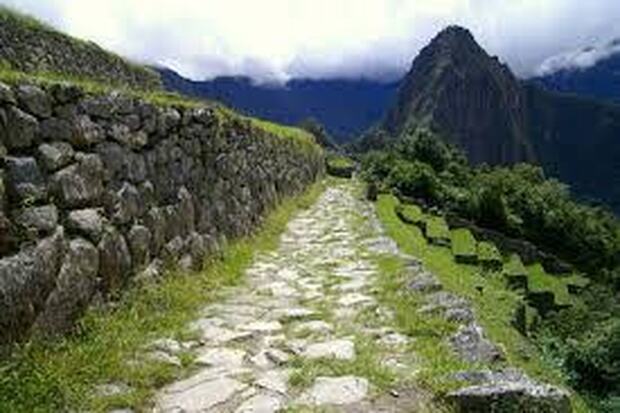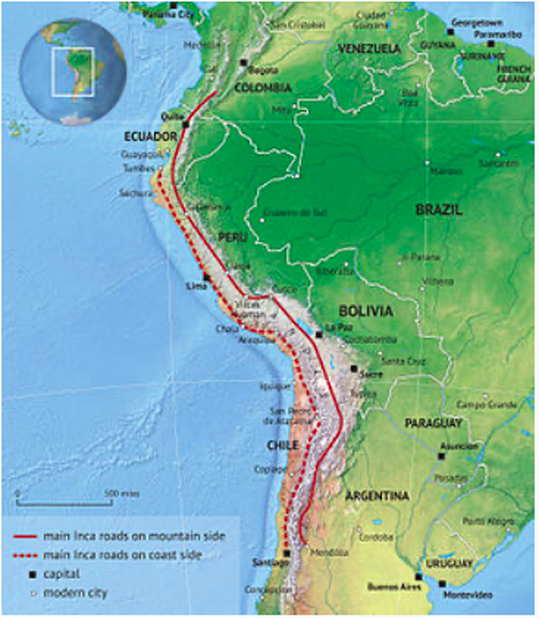 One of the remaining segments of the Incan mountain road. Wikimedia
One of the remaining segments of the Incan mountain road. Wikimedia Roger M. McCoy
The term empire may bring to mind the great realm of Alexander the Great, the Roman Empire, or more recently, the British Empire. Yet there were many empires that seldom get mentioned, such as the Mongol Empire of Genghis Kahn, Chinese Dynastic Empires, and the Persian Empire, among others. Perhaps the empire least likely to come to mind is the empire of the Incas in South America.
A vast civilization known as the Inca Empire covered much of western South America with its center of power in the city of Cuzco, Peru. The Incas came to the Cuzco Valley in the early 1200’s A.D. and began acquiring land. By the time the Spanish invaded in 1532 the Inca Empire covered what is now Peru, Ecuador, most of Bolivia, and parts of Chile and Argentina.
Their empire functioned well without money or markets. Instead of money the Incas used a barter system to exchange goods and services. The exchange system worked among individuals, groups, and ultimately the Inca rulers. The people paid taxes in the form of labor obligations to the empire. The Inca rulers reciprocated by granting access to land and goods. The rulers also threw big feasts annually for all their subjects to enjoy.
When the Spanish conquistador Francisco Pizarro arrived in 1526, he demanded that the Inca ruler, Atahualpa, accept the Spanish king and convert to Christianity. When the ruler refused their demands, the Spanish took him hostage and forced the population to accept Spanish jurisdiction. If this sounds familiar it’s because the same thing happened to the Aztecs in Mexico.
The Royal Roads
As the Incan Empire expanded they, like other empires, soon needed a road network to maintain their power and provide a communication throughout. The Incas built roads and flourished despite having no wheeled vehicles or draft animals to pull plows or carts. The llama, which is the only large animal native to the area, is suitable as a pack animal, but not for pulling loads. They had no iron and no writing system. Yet they created a great empire despite these disadvantages.
Their road network was a web of about 25,000 miles of the western coastal area in South America from present day Columbia and Ecuador into northern Chile and Argentina. The Incas built two primary north-south roads with many tributary and connecting roads. One of the main roads ran along the Pacific coast for 3,100 miles and the other more traveled road was built inland with branches into the mountains covering about 3,500 miles. The city of Cuzco is the center of the Incan road network with roads radiating in the four cardinal directions. The sixteenth-century Spanish historian Garcilaso de la Vega wrote that “Cuzco in the language of the Incas means navel…the Earth’s navel.”
The Incan roads were well-planned and engineered, and can properly be compared to the Roman roads built 1,000 years earlier connecting all of western Europe. The construction using only manual labor required a great amount of time and effort. Many of the roads were paved with stone and in steep terrain they were stair-stepped. The Incas built bridges, retaining walls, and provided for water drainage…all the refinements you would expect in a highway today. The Incan roads provided movement of information, goods, and armies…all with no wheeled vehicles or draft animals in a land of about twelve million people.
The north road from Cuzco to Quito, Ecuador, was the most important which is reflected in its width, ranging from 10 feet to 50 feet. The north road also had larger buildings and other facilities along the way.
Along the roads the Incas built buildings, called tambos, at intervals of a one-day walking distance. The buildings were stocked with provisions and provided quarters for travelers and the running messengers who ran up to 140 miles per day (whew) carrying oral messages which they related to the next messenger who then ran to the next station. Buildings for storage and distribution of goods were located at intervals, and near frontiers of their empire the Incas built fortresses.
In 1553, Pedro Cieza de León, wrote a history and description of Peru, Crónicas del Perú. His chronicles had this to say about the Incan roads.
I believe that, since the memory of people, it has not been
read of such a greatness as this road, made through deep
valleys and high peaks, snow covered mountains, marshes
of water, live rock, and beside furious rivers; in some parts
it was flat and paved, on the slopes well made. …Everywhere
it was clean, swept clear of debris, full of dwellings, warehouses
for valuable goods, temples of the Sun, and relay stations that
were on this road.
During the Spanish colonial period the Incan roads fell into disuse. The Spanish brought horses, oxen, and wheeled carts, which were of limited use on the steep or stair-stepped Incan roads. Soon most of the roads were abandoned. Most of the roadways were destroyed over time and only one-quarter of the roads are still visible today.
Sources
Mann, Charles C. 1491: New Revelations of the Americas Before Columbus. New York: Knopf. 2005.
McEwen, Gordon F. The Incas: New Perspectives. New York. W. W. Norton & Company. 2008.
Inca Empire. https://en.wikipedia.org/wiki/Inca_Empire
Inca Road System. https://en.wikipedia.org/wiki/Inca_road_system
The Inca Road System (Ancient History Encyclopedia)
https://www.ancient.eu/article/757/the-inca-road-system/
The term empire may bring to mind the great realm of Alexander the Great, the Roman Empire, or more recently, the British Empire. Yet there were many empires that seldom get mentioned, such as the Mongol Empire of Genghis Kahn, Chinese Dynastic Empires, and the Persian Empire, among others. Perhaps the empire least likely to come to mind is the empire of the Incas in South America.
A vast civilization known as the Inca Empire covered much of western South America with its center of power in the city of Cuzco, Peru. The Incas came to the Cuzco Valley in the early 1200’s A.D. and began acquiring land. By the time the Spanish invaded in 1532 the Inca Empire covered what is now Peru, Ecuador, most of Bolivia, and parts of Chile and Argentina.
Their empire functioned well without money or markets. Instead of money the Incas used a barter system to exchange goods and services. The exchange system worked among individuals, groups, and ultimately the Inca rulers. The people paid taxes in the form of labor obligations to the empire. The Inca rulers reciprocated by granting access to land and goods. The rulers also threw big feasts annually for all their subjects to enjoy.
When the Spanish conquistador Francisco Pizarro arrived in 1526, he demanded that the Inca ruler, Atahualpa, accept the Spanish king and convert to Christianity. When the ruler refused their demands, the Spanish took him hostage and forced the population to accept Spanish jurisdiction. If this sounds familiar it’s because the same thing happened to the Aztecs in Mexico.
The Royal Roads
As the Incan Empire expanded they, like other empires, soon needed a road network to maintain their power and provide a communication throughout. The Incas built roads and flourished despite having no wheeled vehicles or draft animals to pull plows or carts. The llama, which is the only large animal native to the area, is suitable as a pack animal, but not for pulling loads. They had no iron and no writing system. Yet they created a great empire despite these disadvantages.
Their road network was a web of about 25,000 miles of the western coastal area in South America from present day Columbia and Ecuador into northern Chile and Argentina. The Incas built two primary north-south roads with many tributary and connecting roads. One of the main roads ran along the Pacific coast for 3,100 miles and the other more traveled road was built inland with branches into the mountains covering about 3,500 miles. The city of Cuzco is the center of the Incan road network with roads radiating in the four cardinal directions. The sixteenth-century Spanish historian Garcilaso de la Vega wrote that “Cuzco in the language of the Incas means navel…the Earth’s navel.”
The Incan roads were well-planned and engineered, and can properly be compared to the Roman roads built 1,000 years earlier connecting all of western Europe. The construction using only manual labor required a great amount of time and effort. Many of the roads were paved with stone and in steep terrain they were stair-stepped. The Incas built bridges, retaining walls, and provided for water drainage…all the refinements you would expect in a highway today. The Incan roads provided movement of information, goods, and armies…all with no wheeled vehicles or draft animals in a land of about twelve million people.
The north road from Cuzco to Quito, Ecuador, was the most important which is reflected in its width, ranging from 10 feet to 50 feet. The north road also had larger buildings and other facilities along the way.
Along the roads the Incas built buildings, called tambos, at intervals of a one-day walking distance. The buildings were stocked with provisions and provided quarters for travelers and the running messengers who ran up to 140 miles per day (whew) carrying oral messages which they related to the next messenger who then ran to the next station. Buildings for storage and distribution of goods were located at intervals, and near frontiers of their empire the Incas built fortresses.
In 1553, Pedro Cieza de León, wrote a history and description of Peru, Crónicas del Perú. His chronicles had this to say about the Incan roads.
I believe that, since the memory of people, it has not been
read of such a greatness as this road, made through deep
valleys and high peaks, snow covered mountains, marshes
of water, live rock, and beside furious rivers; in some parts
it was flat and paved, on the slopes well made. …Everywhere
it was clean, swept clear of debris, full of dwellings, warehouses
for valuable goods, temples of the Sun, and relay stations that
were on this road.
During the Spanish colonial period the Incan roads fell into disuse. The Spanish brought horses, oxen, and wheeled carts, which were of limited use on the steep or stair-stepped Incan roads. Soon most of the roads were abandoned. Most of the roadways were destroyed over time and only one-quarter of the roads are still visible today.
Sources
Mann, Charles C. 1491: New Revelations of the Americas Before Columbus. New York: Knopf. 2005.
McEwen, Gordon F. The Incas: New Perspectives. New York. W. W. Norton & Company. 2008.
Inca Empire. https://en.wikipedia.org/wiki/Inca_Empire
Inca Road System. https://en.wikipedia.org/wiki/Inca_road_system
The Inca Road System (Ancient History Encyclopedia)
https://www.ancient.eu/article/757/the-inca-road-system/

 RSS Feed
RSS Feed
